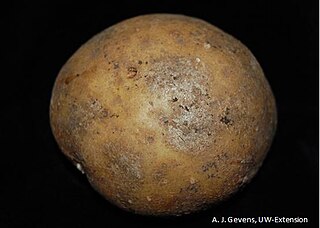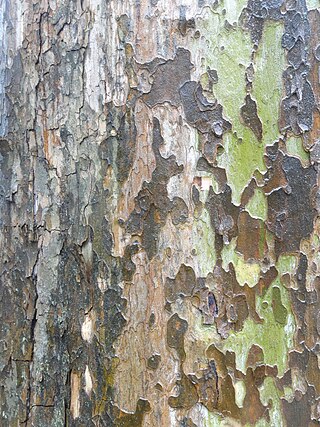
Fusarium wilt is a common vascular wilt fungal disease, exhibiting symptoms similar to Verticillium wilt. This disease has been investigated extensively since the early years of this century. The pathogen that causes Fusarium wilt is Fusarium oxysporum. The species is further divided into formae speciales based on host plant.

Phytophthora cinnamomi, also known as cinnamon fungus, is a soil-borne water mould that produces an infection which causes a condition in plants variously called "dieback", "root rot", or, "ink disease".

Verticillium wilt is a wilt disease affecting over 350 species of eudicot plants. It is caused by six species of Verticillium fungi: V. dahliae, V. albo-atrum, V. longisporum, V. nubilum, V. theobromae and V. tricorpus. Many economically important plants are susceptible including cotton, tomatoes, potatoes, oilseed rape, eggplants, peppers and ornamentals, as well as others in natural vegetation communities. Many eudicot species and cultivars are resistant to the disease and all monocots, gymnosperms and ferns are immune.

Ophiostoma ulmi is a species of fungus in the family Ophiostomataceae. It is one of the causative agents of Dutch elm disease. It was first described under the name Graphium ulmi, and later transferred to the genus Ophiostoma.

Monilinia laxa is a plant pathogen that is the causal agent of brown rot of stone fruits.

Gibberella zeae, also known by the name of its anamorph Fusarium graminearum, is a fungal plant pathogen which causes fusarium head blight (FHB), a devastating disease on wheat and barley. The pathogen is responsible for billions of dollars in economic losses worldwide each year. Infection causes shifts in the amino acid composition of wheat, resulting in shriveled kernels and contaminating the remaining grain with mycotoxins, mainly deoxynivalenol (DON), which inhibits protein biosynthesis; and zearalenone, an estrogenic mycotoxin. These toxins cause vomiting, liver damage, and reproductive defects in livestock, and are harmful to humans through contaminated food. Despite great efforts to find resistance genes against F. graminearum, no completely resistant variety is currently available. Research on the biology of F. graminearum is directed towards gaining insight into more details about the infection process and reveal weak spots in the life cycle of this pathogen to develop fungicides that can protect wheat from scab infection.

Macrophomina phaseolina is a Botryosphaeriaceae plant pathogen fungus that causes damping off, seedling blight, collar rot, stem rot, charcoal rot, basal stem rot, and root rot on many plant species.

Phytophthora erythroseptica—also known as pink rot along with several other species of Phytophthora—is a plant pathogen. It infects potatoes causing their tubers to turn pink and damages leaves. It also infects tulips (Tulipa) damaging their leaves and shoots.
Ceratocystis paradoxa or Black Rot of Pineapple is a plant pathogen that is a fungus, part of the phylum Ascomycota. It is characterized as the teleomorph or sexual reproduction stage of infection. This stage contains ascocarps, or sacs/fruiting bodies, which contain the sexually produced inoculating ascospores. These are the structures which are used primarily to survive long periods of time or overwinter to prepare for the next growing season of its host. Unfortunately, the sexual stage is not often seen in the natural field but instead the anamorph, or asexual stage is more commonly seen. This asexual stage name is Thielaviopsis paradoxa and is the common cause of Black rot or stem-end rot of its hosts.

Phellinus noxius is a plant pathogen. It attacks a wide range of tropical plants, and is the cause of brown root rot disease. It was described as "an aggressive and destructive pathogen". The pathogen invades roots with contact between roots of a potential host with the substrate on which the fungus is growing.

Helminthosporium solani is a fungal plant pathogen responsible for the plant disease known as silver scurf. Silver scurf is a blemish disease, meaning the effect it has on tubers is mostly cosmetic and affects "fresh market, processing and seed tuber potatoes." There are some reports of it affecting development, meaning growth and tuber yield. This is caused by light brown lesions, which in turn change the permeability of tuber skin and then it causes tuber shrinkage and water loss, which finally causes weight loss. The disease has become economically important because silver scurf affected potatoes for processing and direct consumption have been rejected by the industry. The disease cycle can be divided into two stages: field and storage. It is mainly a seed borne disease and the primary source of inoculum is mainly infected potato seed tubers. Symptoms develop and worsen in storage because the conditions are conducive to sporulation. The ideal conditions for the spread of this disease are high temperatures and high humidity. There are also many cultural practices that favor spread and development. There are multiple ways to help control the disease.
Rhizopus soft rot is a disease of the sweet potato. It is one of the most common to affect the sweet potato, happening during packing and shipping. The disease causes a watery soft rot of the internal portion of the storage root. Strategies to manage the disease include the development of resistant varieties, curing through the use of heat and humidity, and application of decay control products.

The Microascales are an order of fungi in the class Sordariomycetes, subclass Hypocreomycetidae. This is a relatively small order of mostly saprobic fungi that live in soil, rotting vegetation and dung. Some species are plant pathogens, such as Ceratocystis fimbriata, transmitted by beetles to living trees and causing cacao wilt and many other economically important diseases. Species in the genus Pseudallescheria are pathogenic to humans The order was circumscribed in 1980. Wijayawardene et al. in 2020 added more families and genera to the order.

Ceratocystis is a genus of fungi in the family Ceratocystidaceae. Several species are important plant pathogens, causing diseases such as oak wilt and pineapple black rot.
Pineapple black rot, also known as butt rot, base rot, or white blister, is a disease caused by Ceratocystis paradoxa (teleomorph). C. paradoxa also causes disease in a variety of other tropical plants such as banana, coconut, and sugarcane making it a somewhat dangerous pathogen. Pineapple black rot is the most common and well-known post-harvest disease of the pineapple fruit and is responsible for serious losses in the fresh pineapple fruit world industry. The pathogen is a polyphagous wound parasite and gains entry into the fruit via wounds sustained during and after harvest. The disease only shows up in fresh fruit because the time from harvest to processing it too short for infection occur. Infection can also occur out in the field, but it is not nearly as common as post-harvest infection.
Gummy stem blight is a cucurbit-rot disease caused by the fungal plant pathogen Didymella bryoniae. Gummy stem blight can affect a host at any stage of growth in its development and affects all parts of the host including leaves, stems and fruits. Symptoms generally consist of circular dark tan lesions that blight the leaf, water soaked leaves, stem cankers, and gummy brown ooze that exudes from cankers, giving it the name gummy stem blight. Gummy stem blight reduces yields of edible cucurbits by devastating the vines and leaves and rotting the fruits. There are various methods to control gummy stem blight, including use of treated seed, crop rotation, using preventative fungicides, eradication of diseased material, and deep plowing previous debris.

Ceratocystis platani is a fungus that causes a disease on plane trees in the genus Platanus, mostly in North America and Southern Europe.
Ceratocystis cacaofunesta is an ascomycete fungus that causes a wilt disease in cacao trees. It has led to significant economic losses in Latin America.
Black rot on orchids is caused by Pythium and Phytophthora species. Black rot targets a variety of orchids but Cattleya orchids are especially susceptible. Pythium ultimum and Phytophthora cactorum are known to cause black rot in orchids.

Rapid ʻŌhiʻa Death (ROD) is a fungal disease that is rapidly killing forests of ʻōhiʻa —an ecologically important native tree species within the Hawaiian Islands that has provided a plethora of habitats for endangered birds and other species. Initially reported by landowners in Puna in 2010, ROD spread quickly across tens of thousands of acres of ʻŌhiʻa trees on the Hawaiian Islands. To date, hundreds of thousands of these trees have died from this fungal disease alone. Previously healthy Ōhiʻa trees have been observed to die within a few days to weeks, which is why the disease is known as "Rapid Ōhiʻa Death".














